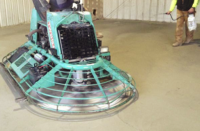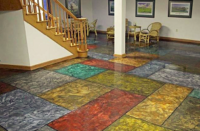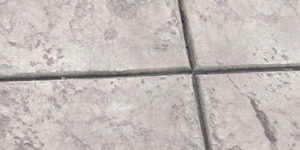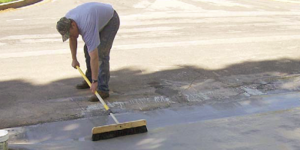Question: We are considering applying an overlay on our gray concrete patio, but the concrete has a large crack running through it. The crack is about 1/16 inch wide, runs the length of the patio, and occurred a month after the slab was put in. It has not changed in size or moved much in the last year.
What caused the crack? And what are the options for dealing with it, since we are going to apply a decorative overlay on the concrete? We talked to multiple contractors about our options, and there are a lot of opinions out there. Some contractors are telling us cracks can’t be fixed, that we should avoid overlaying and rip out and replace the concrete. Others are telling us the cracks can be repaired and an overlay will be a good option. Can you please give us some suggestions?
First, it is important to understand that all concrete cracks! Control joints and expansion joints are typically used to help control where and how concrete cracks, but the reality is that concrete cracks.
In regard to what caused the crack, there are many factors, or combinations of factors, that can cause concrete to crack. At its excellent Concrete Technology website, the Portland Cement Association identifies some common causes of cracking as drying shrinkage, heat- or cold-induced contraction, shortening restraint, subgrade settling and applied loads.
In your particular case, the culprit sounds like it may have been subgrade settling. Movement or settling of the subbase can result in the concrete not being properly supported in certain areas. Since concrete is a rigid material, it cracks in response to the stress of not being supported evenly. The good news in your case is that the crack has not grown or changed in the last year, which indicates it was a one-time crack, for which there are multiple repair options.
Dealing with the crack prior to applying the decorative overlay, you have the widest possible range of opinions to consider. Based on my personal experience and discussions with decorative concrete installers around the country, cracks can be dealt with and controlled so they do not increase in size or shadow through the overlay. However, there are many professional contractors who do not believe in any type of crack repair or control systems. They prefer to replace the concrete completely instead of dealing with cracks and overlays.
I suggest that anyone seriously considering having crack-repair work done obtain multiple opinions, do some research on their own, and if the project warrants, possibly even consult with a structural engineer to weigh the options and costs. In your case it sounds like crack repair is a good option, and if the work is completed properly, it should result in no shadowing or growth of the existing crack. What no one can guarantee is that additional cracks will not form in the existing slab and cause a problem down the road.
The options for crack repair when working with a decorative overlay fall into three main categories: polymer filling, crack-suppression membrane systems and concrete stitching.
Polymer filling is probably the most common method of general crack repair. The method involves preparing and cleaning the crack to remove any loose material, then filling the crack with a liquid polymer “glue” that achieves very high strength, often far stronger then the concrete itself. The most common polymers used are epoxy, polyurea and polyurethane. These liquid polymers are poured or injected into the crack in a liquid state, bond to the concrete on both sides of the crack, and cure to a rigid, hard state, filling the void and tying the concrete together.
In some scenarios, where the cracks are wide, a piece of mesh can be embedded into the polymer to provide additional stability and prevent shadowing. Sand is often broadcast on the surface of the polymer material while it is still tacky to provide a good surface for the overlay to bond. There are many proven products on the market that are typically sold in kit or cartridge systems and require very little in the way of handling. These systems are cost-effective and in many cases fast-curing, allowing for the overlay work to proceed within hours of the crack repair material being applied.
Crack-suppression coatings or membrane systems are less common but work well when cracking is more widespread. These systems employ either a polymer or cement-based coating and a thin fabric that covers the entire area being treated. In most cases a primer is applied, followed by the polymer or cement-based coating, into which the fabric is stretched. A second and sometimes a third coating is applied to completely encapsulate the fabric. This process creates an impermeable membrane that keeps the cracks from shadowing through.
In cases where cracks are wide, it is recommended that they be filled as described above before the suppression membrane system is applied. These systems can also be engineered to provide excellent water or chemical resistance when used on concrete covering wooden decks or in industrial environments.
Stitching concrete has been around for some time, but in most cases it has been relegated to structural concrete. This method involves using metal staples to tie the concrete together on each side of the crack. This is done by making saw cuts into the concrete surface perpendicular to the crack at designated points along its length. Holes are drilled at each end of the saw cut to allow for the staples’ tapered ends. After the metal stitch is placed, the saw cut and hole is filled with either a cement-based nonshrink grout or polymer crack repair material. This method of crack repair is often used when the crack is dynamic and moving or affecting the structural integrity of the concrete.
All of these methods are viable options when dealing with cracks prior to applying an overlay, but the polymer filling is by far the most common and cost-effective. Also, there are situations where a combination of two or three of these may be used in conjunction successfully.
In your particular situation, using a rigid polymer system in conjunction with stitching would be my recommendation. It is important to remember that the process of crack repair is not performed with aesthetics in mind, and even the most conscientious crack repair work may not guarantee 100 percent crack-free results once the overlay work is completed.
The Portland Cement Association has a website with detailed information on types and causes of cracking: www.cement.org/tech/faq_cracking.asp
Questions from Readers
Question:
No pictures of work in progress or completed work? How can you “talk to multiple contractors” and then not produce proof any of these work. We’ve tried different methods for years unsuccessfully. I would love for someone to show a proven way to accomplish one of these. If it’s not cracked we will overlay. If cracked, tear it out and replace it.
Answer from Concrete Decor:
The three methods for crack repair that are discussed in the article by Chris Sullivan are, in fact, proven methods for crack repair. They are also endorsed by the American Concrete Institute. We would need to see pictures of the cracks you’re facing to determine if one method is better than the other. Remember the old saying: honor thy crack. If it’s a crack that may simply resurface, use the crack(s) in your placement of new or additional control joints when installing your overlay. Don’t ever tell your client that a repair is a permanent fix or that your concrete will never crack. Concrete will crack, even in the best placed concrete applications where mix design, reinforcements and joint placements are to the book.















